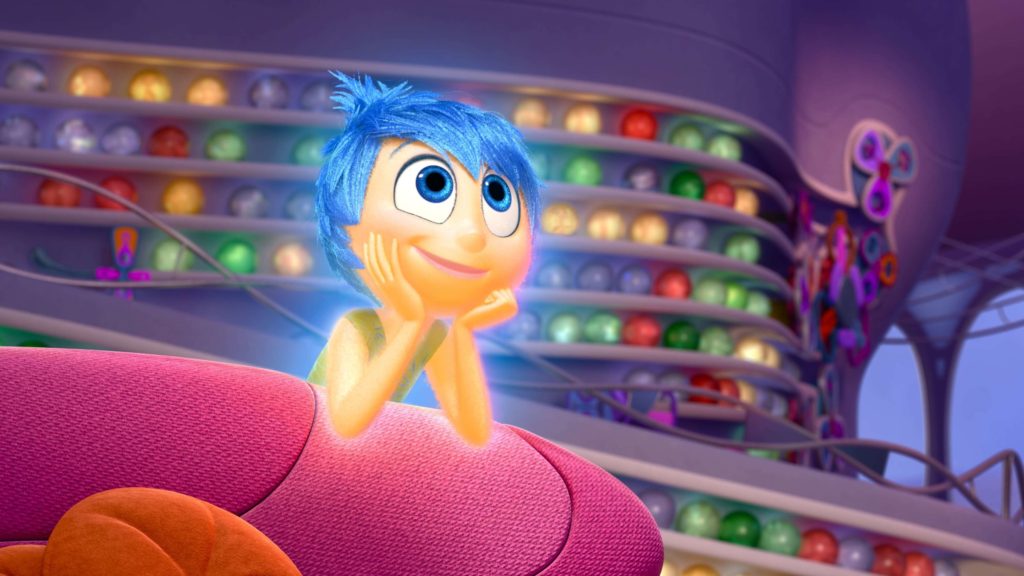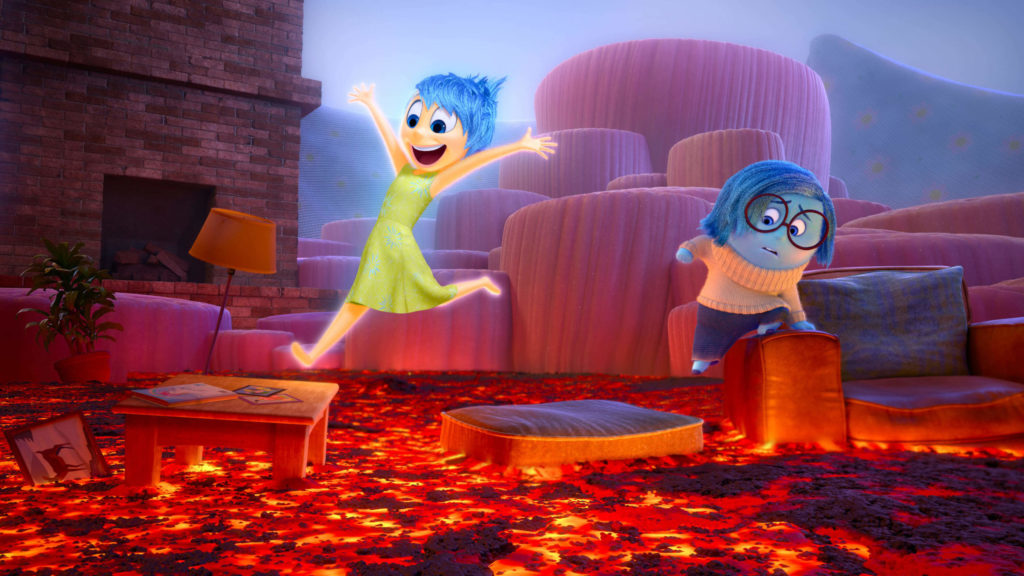Inside Out

2015, PG, Adventure, 1h 35m
Table of Contents
What Is Inside Out About?
A young girl struggles to deal with a move to a new city with her parents, forcing her emotions out of control.
Why You Should Watch Inside Out
Inside Out is a 2015 animated movie from Pixar that explores the inner workings of the human mind. The movie follows the story of a young girl named Riley, whose emotions are personified as five colorful characters who live inside her mind: Joy, Sadness, Anger, Fear, and Disgust. When Joy and Sadness accidentally get sent out of Riley’s mind, they must navigate the strange and unfamiliar landscape of her long-term memories in order to make it back to headquarters and restore balance to her emotions.
Inside Out is a beautifully crafted and emotionally poignant film that explores the complexities of human emotion in a way that is both thought-provoking and entertaining. The film’s unique and imaginative premise is brought to life through its clever writing, endearing characters, and stunning animation.
The five main characters – Joy, Sadness, Anger, Fear, and Disgust – are all well-developed and likable, each with their own distinct personalities and motivations. The voice acting, which includes performances from Amy Poehler, Phyllis Smith, and Lewis Black, is top-notch and perfectly captures the emotions of the characters. Poehler perfectly captures the character’s bubbly and optimistic personality, while also conveying the depth and complexity of her emotions.

The film’s exploration of the importance of all of our emotions, not just the happy ones, is both poignant and important. The idea that sadness and other negative emotions play an essential role in our mental health and well-being is a powerful message that is conveyed beautifully throughout the film. It’s truly a unique and imaginative concept, offering a fresh and creative take on the inner workings of the human mind, personifying emotions as individual characters and giving them distinct personalities and motivations. This is a clever way of exploring complex psychological concepts in a way that is accessible and relatable to a wide audience.
The animation in the film is also really well done, with vibrant and colorful visuals that perfectly capture the emotions of the characters. The world of Riley’s mind is vividly brought to life, from the bustling cityscape of headquarters to the dreamlike landscape of her long-term memories. The character designs are also clever and distinctive, with each emotion having a distinct look and personality.
In addition to its strong storytelling and characters, Inside Out also features some stunning animation. The film’s depiction of the inside of Riley’s mind is imaginative and visually striking, with each location and character brought to life with vibrant colors and detailed design.

One of my favorite takeaways from Inside Out is the way it portrays the importance of sadness in the emotional spectrum. Throughout the movie, Sadness is often seen as a hindrance and an annoyance by the other emotions, who try to keep her away from Riley’s core memories. However, as the story progresses, it becomes clear that Sadness has an important role to play in the development of Riley’s emotional maturity.
It also tackles complex themes such as the role of memories in shaping our emotional identity and the way our emotions can evolve and change over time. As Joy and Sadness journey through Riley’s mind, they encounter old memories that have been forgotten or suppressed, and must navigate the complex landscape of her emotional past in order to make it back to headquarters.
The movie is not just heartwarming, but also humorous. The conversations between the emotions are funny, with the quick dialogue and amusing remarks keeping the viewers captivated and amused.
Inside Out is a beautifully made, emotionally powerful, and thoroughly entertaining film that offers a fresh and creative take on the inner workings of the human mind. Its unique concept, stunning animation, and excellent voice cast make it a must-see for audiences of all ages.
The Theme of Inside Out
The most prominent theme of Inside Out is the significance of acknowledging and embracing one’s emotions, including those perceived as negative. Joy, the dominant emotion in Riley’s mind, initially strives to suppress Sadness, believing that happiness is the only acceptable emotion. However, as the story progresses, Joy comes to understand that Sadness plays a crucial role in Riley’s emotional well-being. This realization highlights the film’s message that all emotions, even those like sadness or anger, are essential and valid. They contribute to our understanding of the world and ourselves, facilitating empathy, deepening relationships, and aiding in personal growth.
Another significant theme is the process of growing up and the emotional turbulence that often accompanies it. Riley’s life is uprooted when her family moves to a new city, triggering a whirlwind of emotional changes. The film brilliantly illustrates the challenges of adolescence, showcasing how external changes can lead to internal turmoil. As Riley navigates her new environment, her emotions struggle to adapt, symbolizing the often chaotic transition from childhood to adolescence. This theme resonates with audiences of all ages, as it captures the universal experience of growth and the evolving nature of our emotional lives.

Inside Out also touches on the theme of memory and identity. Memories, depicted as colored orbs in the film, are shown to be influenced by the prevailing emotions at the time of their creation. This visualization emphasizes the impact of emotions on our recollections and, by extension, on our sense of self. The film explores how memories are not static but are continually reshaped by our current emotional state, suggesting that our identity is fluid and shaped by our ongoing experiences and feelings.
The film delves into the complexity of the human mind. It personifies abstract concepts like the subconscious, dreams, and core memories, making them accessible and understandable, especially to younger audiences. This creative representation serves to demystify aspects of psychology, presenting them in a way that is both entertaining and educational.
Inside Out is a profound exploration of emotional intelligence, growth, and the human psyche. By personifying emotions and creatively visualizing the workings of the mind, the film provides valuable insights into how we process experiences and the importance of embracing all our emotions. It not only entertains but also educates, leaving viewers with a deeper understanding of the emotional complexities that underpin our lives.
The Cinematography of Inside Out
Inside Out (2015) employed a distinctive visual style that blended traditional hand-drawn animation with computer-generated imagery (CGI). The film was made using a combination of 2D hand-drawn sketches and 3D computer-generated models, creating a hybrid visual style that was both innovative and eye-catching.

The cinematography employed a wide range of visual techniques, including bold, vibrant colors, imaginative camera movements, and innovative lighting and shading techniques. The film’s designers used the colors of the five emotions to create a visual shorthand for each character, making it easy for audiences to quickly identify and understand each emotion’s personality and motivations.
Inside Out also drew on a wide range of visual references, including classic Disney animated films, as well as surrealist and cubist art. The film’s designers used these references to create a rich and imaginative world inside Riley’s mind, full of colorful landscapes, strange creatures, and otherworldly environments.
The Soundtrack of Inside Out
The soundtrack was composed by Michael Giacchino. The score was recorded with a 60-piece orchestra, and features a playful and whimsical sound that reflects the film’s imaginative setting inside the mind of a young girl named Riley.
The soundtrack features several memorable themes, including the “Bundle of Joy” theme, which is associated with the character of Joy, and the “Sadness” theme, which reflects the film’s more introspective and emotional moments. The music in the film is designed to support and enhance the film’s story and characters, and to help create a rich and immersive audio-visual experience for audiences.
You can listen to the motion picture soundtrack below.
The Cast of Inside Out
- Amy Poehler as Joy: a yellow, spherical and energetic emotion who acts as the protagonist of the film.
- Phyllis Smith as Sadness: a blue, tearful emotion who becomes the accidental cause of the film’s events.
- Lewis Black as Anger: a red, fiery emotion who is easily triggered.
- Bill Hader as Fear: a purple, nervous emotion who is responsible for Riley’s safety.
- Mindy Kaling as Disgust: a green, sarcastic emotion who is responsible for protecting Riley’s well-being.
- Richard Kind as Bing Bong: Riley’s imaginary friend, a pink elephant-cat-dolphin hybrid.

The Filmmakers of Inside Out
- Pete Docter is a writer, animator, and director who has been with Pixar Animation Studios for over two decades. He was the chief creative officer at Pixar and has directed several critically acclaimed films, including “Up” (2009) and “Monsters, Inc.” (2001).
- Ronnie del Carmen is an animator, storyboard artist, and director who has worked on several Pixar films, including “Up” (2009) and “Finding Nemo” (2003).
- Jonas Rivera is a producer who has worked on several Pixar films, including “Up” (2009) and Inside Out (2015).
- Meg LeFauve is a screenwriter who has worked on several films, including “The Good Dinosaur” (2015) and “Captain Marvel” (2019).
- Josh Cooley is a writer and animator who has worked on several Pixar films, including “Toy Story 3” (2010) and Inside Out (2015).

Broccoli Flatbread

Inspiration
Riley Gets Broccoli Pizza With Mom

More About Inside Out
Looking for a fun and engaging way to teach emotional intelligence to your students? Check out this free Inside Out worksheet, inspired by the popular movie, allows students to explore and understand complex emotions in a relatable way. Encourage self-reflection, critical thinking, and make learning more enjoyable with this popular and accessible resource.
Hope you find it helpful!

